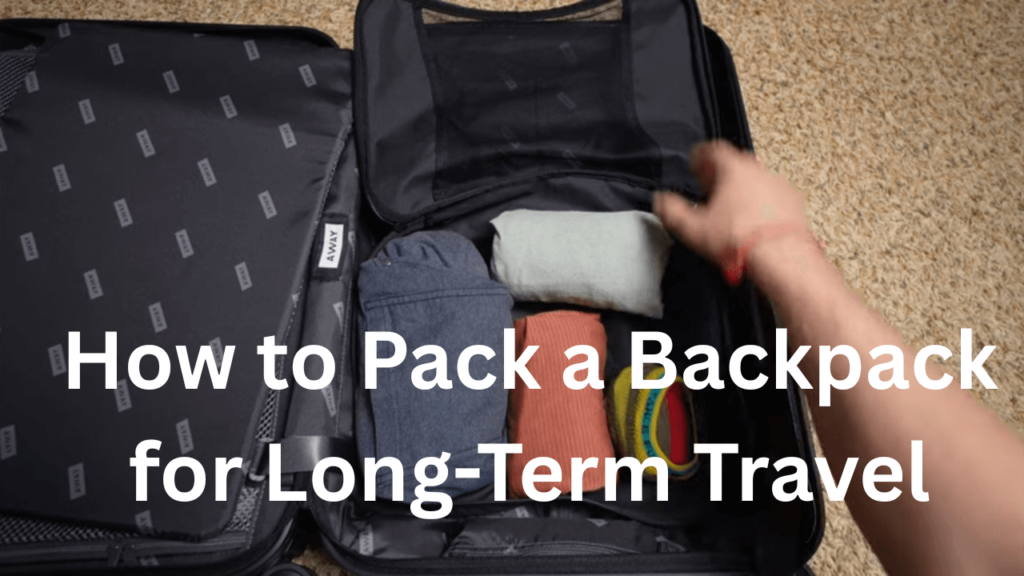With remote work, gap years, digital nomadism, and long-term sabbaticals on the rise, long-term travel has become more accessible than ever. According to a 2024 report by Statista, over 37% of Gen Z and Millennials planned to travel for over 30 days in a year, citing freedom, work flexibility, and exploration as their top motivators.
But this freedom hinges on one surprisingly vital skill: efficient backpack packing. Whether you’re backpacking through Southeast Asia, volunteering in South America, or working remotely from Eastern Europe, packing smart can make or break your travel experience. A well-packed backpack lightens your load—literally and mentally—and ensures you’re ready for anything from beach days to snowstorms.
As someone who’s traveled long-term across 17 countries with only a 40L backpack, I’ve learned through trial and error (and some painful mistakes) what truly matters when packing for the long haul. This article combines my personal insights, expert-backed strategies, and practical tips to help you pack your backpack efficiently—and travel smarter.
Choosing the Right Backpack
A backpack isn’t just luggage—it’s your mobile base. Here’s what to look for:
Size & Capacity
| Backpack Size | Duration | Ideal Use Case |
|---|---|---|
| 30–40L | 1–2 weeks | Minimalist or short trip |
| 45–55L | 1–6 months | Long-term travelers, carry-on compatible |
| 60L+ | 6+ months | Trekkers, campers, gear-heavy travelers |
Pro tip: I used the Osprey Farpoint 55—modular, front-loading, and airline-carry-on-friendly. Avoid top-loading backpacks if you’re city-hopping or need regular access.
Features to Prioritize:
- Padded hip belt (transfers weight to hips)
- Water-resistant material
- Lockable zippers
- Multiple compartments
- Detachable daypack
Expert insight: Travel gear expert Rolf Potts, author of Vagabonding, emphasizes minimalist packing: “You can always buy things along the way. What you leave behind is often more important than what you bring.”
Core Packing Principles
1. The Rule of Thirds:
Split your gear into thirds:
- Clothing (⅓)
- Electronics & Essentials (⅓)
- Toiletries & Miscellaneous (⅓)
This creates mental boundaries and prevents overpacking.
2. Pack for a Week, Not a Year:
Even if you’re traveling for 12 months, pack as if you’re going for 7–10 days. Laundry services exist everywhere.
3. Versatility Over Volume:
Choose items you can mix, match, and layer. That jacket that only works with one outfit? Leave it.
What to Pack (and What to Leave Behind)
1.Clothing: Pack Light, Layer Right
The “One-Week Rule”:
Only pack enough clothes for 7–10 days. You can do laundry on the road.
Essential Clothing List:
- 3–5 T-shirts or tops (quick-dry preferred)
- 1–2 long-sleeve shirts (one nice/dressy)
- 2–3 pairs of pants (1 jeans, 1 travel/hiking, 1 leggings or joggers)
- 1 pair of shorts
- 7 pairs of underwear & socks
- 1 light fleece or sweater
- 1 waterproof shell or rain jacket
- 1 swimsuit
- Sleepwear
- A scarf or sarong (multipurpose)
🧠 Note: Studies by the International Journal of Environmental Research and Public Health (2023) found that moisture-wicking and quick-dry fabrics reduce traveler discomfort in humid climates.
My Experience: I overpacked my first time and ditched half of it by week three. The real MVPs? My Uniqlo ultra-light down jacket and Merino wool socks—lightweight, compact, odor-resistant.
2. Toiletries: Minimize and Go Solid
Essentials:
- Toothbrush, floss, toothpaste
- Solid shampoo and conditioner bars
- Razor & small shaving cream
- Travel towel (quick-dry)
- Deodorant (solid or crystal)
- Nail clippers & tweezers
- Menstrual products (if applicable)
- Small first-aid kit (plasters, ibuprofen, antihistamines, rehydration salts)
Why Solid Toiletries?
They’re TSA-approved, eco-friendly, and won’t spill. Brands like Ethique and Lush offer excellent solid shampoo and conditioner bars.
3. Tech & Travel Accessories
Depending on your needs, especially if you’re a digital nomad, your tech bag may include:
Essential Electronics:
- Smartphone + universal SIM or eSIM
- Travel adapter (universal with USB ports)
- Power bank (10,000mAh+)
- Headphones or earbuds
- Charging cables
- Laptop or tablet (if working)
- Kindle or e-reader (lightweight alternative to books)
💡 Tip from Nomadic Matt: Bring a 3-way plug or mini extension cord—you’ll often find limited power outlets in hostels.
4. Travel Documents and Money
Store all essentials in a waterproof travel wallet or pouch.
Must-Haves:
- Passport (+ 2 photocopies or digital copies)
- Vaccination certificate (if required)
- Travel insurance papers
- Emergency contacts
- Debit/credit cards + backup
- Local currency (for at least the first 2–3 days)
- Backup USD/EUR cash
Use RFID-blocking sleeves or wallets for extra security.
My Tip: Keep a Google Drive or Dropbox folder with scanned documents in case of loss.
5. Health, Safety & Hygiene
You don’t want to be caught unprepared in remote areas or with stomach bugs.
Essentials:
- Reusable water bottle with filter (e.g., LifeStraw Go)
- Hand sanitizer
- Mosquito repellent (especially in tropical zones)
- Face masks (for urban areas or dust)
- Prescription meds (enough for the trip + paper script)
- Condoms (access varies by country)
- Travel insurance (World Nomads or SafetyWing are good picks)
6. Optional but Useful Items
- Micro headlamp or mini flashlight
- Sewing kit
- Safety whistle
- Duct tape (wrap some around a pen)
- Ziplock bags (wet clothes, electronics, snacks)
- Journal or travel notebook
- Foldable tote bag or shopping bag
How to Pack: The Art of Organization
1. Use Packing Cubes:
Categorize clothes (e.g., tops, bottoms, underwear). It speeds up repacking and keeps things tidy.
2. Roll, Don’t Fold:
Rolling clothes not only saves space but reduces wrinkles.
3. Place Heaviest Items Close to Your Back:
This centers gravity and reduces strain.
4. Use Compression Sacks:
Great for bulky items like jackets or sleeping bags.
5. Stash Essentials in the Top Pocket:
Keep passports, wallet, and toiletries where you can reach them fast.
Tips for Specific Climates and Regions
Tropical Asia (Thailand, Vietnam, Philippines):
- Prioritize breathable fabrics (linen, cotton)
- Mosquito repellent & lightweight long-sleeves
- Flip-flops and quick-dry towels are essential
Europe (Spring/Fall):
- Layering is key—think base layers and a waterproof shell
- Stylish but comfortable walking shoes
- A travel umbrella is often better than a bulky raincoat
South America (Andes regions):
- Altitude shifts require both warm and cool layers
- A reliable fleece and windbreaker combo is a must
FAQs:
Q1: Should I bring a tent or sleeping bag?
Only if you’re camping. Otherwise, hostels and guesthouses are abundant in most places.
Q2: What about laundry?
Most guesthouses/hostels offer laundry for a fee. Or, buy a travel wash bag like the Scrubba for DIY.
Q3: How do I keep valuables safe?
Use a money belt or lockable packing cubes. Keep digital backups of everything. Hostels with lockers? Always use them.
Q4: Should I carry food?
Carry high-protein snacks (nuts, bars), but don’t waste space on bulky items. Local food is part of the adventure.
Final Thoughts: Travel Light, Travel Far
Packing for long-term travel is less about fitting everything you might need and more about learning what you truly need. It’s a mindset shift. You’ll discover how little you require to feel comfortable, clean, and capable on the road.
When I started my journey across Asia, I packed too much—three jackets, two extra pairs of shoes, and a pile of gadgets. Within a month, I donated half of it. What remained fit into a 45L bag and supported me across four countries, five climates, and countless adventures.
Ask Me Anything!
Still wondering if you should bring your DSLR? Confused between 40L and 55L backpacks? I’m happy to help based on real travel experience. Drop your questions below—I’ll answer every one of them.

Hi, I’m Tanvir, the founder and author of Explore Ireland Now. With a deep love for Ireland and its rich culture, history, and landscapes, I created this site to share everything that makes this beautiful country worth exploring. Whether you’re a local looking for hidden gems or a traveler planning your next adventure, I provide insightful guides, tips, and recommendations to help you experience Ireland to the fullest.
From stunning landscapes to vibrant cities and quaint villages, Ireland is full of wonders waiting to be discovered. Through my personal experiences and research, I aim to bring you the most up-to-date information and inspiration for your journey.
Thank you for visiting Explore Ireland Now—I hope my content helps you uncover all that this incredible country has to offer! If you have any questions or need travel advice, feel free to reach out.



